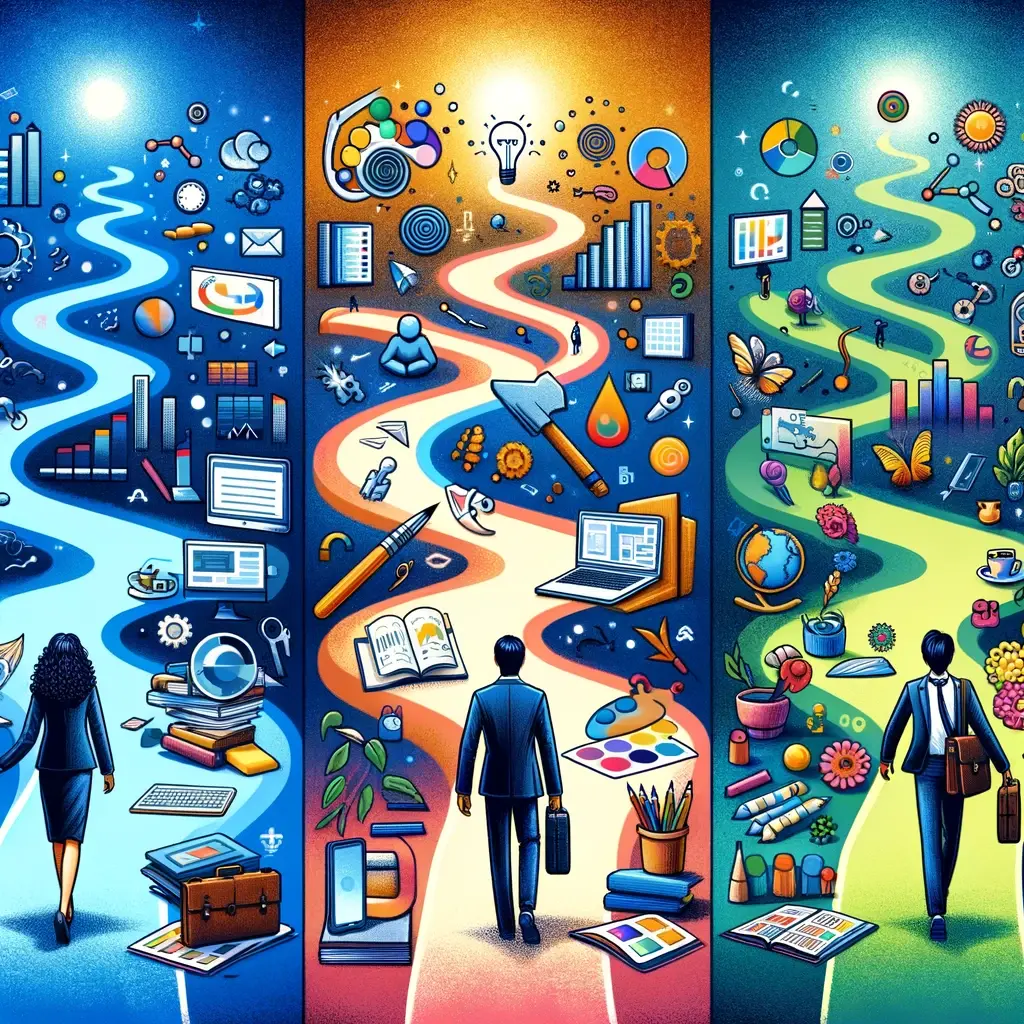Why needs-based segmentation is a must for great UX (and how to implement it)
Needs-based segmentation, a strategy that segments users based on their unique needs and usage patterns, is fundamental to great user experience (UX) and onboarding processes.

If you asked most people to segment their user base, they'd probably come back with demographics:
- Enterprise companies
- Startups
- Senior-level employee
- Age 25-40
- High-income
- Trial users
- Likes sports
- etc.
Depending on what your product does, these may help you distinguish if someone fits your ICP. But they don't help you figure out what users actually need.
That's why it's so frustrating when we hear the "user friendliness", but don't actually know what to optimize for—because these criteria aren't very useful.
Does a new user in an enterprise need a different experience than a new user in a startup? Does a senior-level new user need something different than a junior-level new user? These aren't easy questions to answer.
We find that needs-based segmentation is way better than generic "user-friendliness".
It's not that user friendliness is wrong, but it fails to capture the reality that user friendliness is really a blanket term and a pathetic wave towards a much more complex reality. Your users are not a monolith, and being user friendly doesn't mean one thing. In fact, as software products expand across new devices, new geographies, and new use cases, it's becoming harder and harder for user friendliness to be a simple matter of checking the right boxes.
The importance of understanding and catering to the specific needs of users has never been more paramount. So how do you do that effectively?

Needs-based segmentation, a strategy that segments users based on their unique needs and usage patterns, is fundamental to great user experience (UX) and onboarding processes.
This approach goes beyond traditional demographic or industry-based segmentation, diving deeper into the specific requirements, behaviors, and preferences of users. As we explore this concept, we'll also delve into how implementing a user assistance platform can help you structure your needs base segmentation strategy.
Key Takeaways
- Complexity of User Friendliness: Recognizes the unique and evolving needs of each user, moving beyond a one-size-fits-all approach.
- Strategic Needs-Based Segmentation: Focuses on segmenting users based on their specific needs and behaviors, not just demographics.
- Enhanced User Experience (UX): Tailors UX design to meet the distinct requirements of different user segments, increasing usability and satisfaction.
- Customized User Onboarding: Utilizes personalized onboarding processes for different user segments, enhancing efficiency and engagement from the first interaction.
- Improved Engagement and Retention: Personalized onboarding and UX design lead to higher user adoption, loyalty, and overall satisfaction.
- Role of Command AI in Segmentation: Provides AI-powered, user-specific assistance, integrating seamlessly into UX strategies and offering insights for continuous improvement and user-centric adaptation.
Why you need needs-based segmentation
There’s no shortage of user segmentation strategies. In fact, maybe there are too many of them!
But there’s one that is user-centric which focuses on how to best serve your customers the most.
Needs-based segmentation involves dividing a user base into distinct groups, each characterized by unique requirements and preferences. Unlike conventional segmentation that might focus on age, location, or industry, this approach zeroes in on what users actually need and how they interact with a digital product. This granularity allows for a more nuanced understanding of the user base, paving the way for highly tailored experiences.
Benefits in the UX realm
The advantages of this method are manifold in the context of UX design. By aligning product design and features with the specific needs of different user groups, developers and designers can create interfaces that resonate more deeply with each segment. This alignment leads to increased usability, higher satisfaction rates, and, ultimately, a stronger connection between the user and the digital product.
User onboarding
The first interaction a user has with a software is crucial – it sets the tone for their entire experience. Needs-based segmentation allows for the creation of personalized onboarding processes that directly address the unique requirements of different user segments. This personalization ensures that users are introduced to features and functionalities that are most relevant to their specific needs, making the onboarding process not only more efficient but also more engaging.
The impact on engagement and retention
A well-segmented onboarding experience significantly enhances user engagement. Users feel understood and valued when they see that the software caters to their specific needs right from the start. This relevance can dramatically increase the likelihood of users fully adopting the software, reducing churn rates, and fostering long-term loyalty. Moreover, when users are quickly able to see the value in a software, it accelerates their journey from novice to proficient users, enhancing overall satisfaction with the product.
Strategies for effective needs-based segmentation in UX
Implementing needs base segmentation isn't rocket science, but it does require some intentional data collection of thought.

Identifying user segments
The journey towards effective needs-based segmentation begins with accurately identifying distinct user groups. This step involves a thorough analysis of user behaviors, feedback, and usage patterns, often facilitated by analytics platforms and user feedback mechanisms. The objective is to discern the diverse goals and interactions different users have with your software.
Designing for specific needs
Having identified the user segments, the focus shifts to tailoring the UX to meet these specific needs. This can mean creating varied user interfaces, feature sets, or content strategies for each segment. The ultimate goal is to deliver a UX so personalized that each user feels the software is uniquely catering to their needs, thereby boosting engagement.
Constant analysis and improvement
It's not enough to just understand your users and design for them. Inevitably, you'll fall short or they'll want to do something different than when you expected. That's why it's important to make sure you have a robust data collection system in place that understands how each of your segments are interacting with your product. If you do this, you'll be able to quickly tweak and A/B test different features.
Enhancing UX with the right segmentation
There's no one right path within your product (most of the time,) which means your UX can look a little like this:

So how do you actually improve user onboarding with this segmentation? Here’s three easy ways to get quick wins:
Crafting personalized onboarding flows
In a needs-based approach, personalizing the onboarding experience for different user segments is crucial. This could involve designing varied onboarding experiences—new users might receive more foundational guidance, while experienced users are introduced to more advanced features or shortcuts.
Utilizing interactive elements
Incorporating interactive elements such as in-app walkthroughs, tooltips, and guides can significantly refine the onboarding process for each user segment. These tools are customized to address the unique challenges or queries of each segment, ensuring a more effective and engaging onboarding experience.
Measuring success and iterating
An essential aspect of segmented onboarding is the continuous evaluation of its effectiveness. Employing methods like A/B testing, user feedback, and analyzing engagement metrics can shed light on how well the onboarding is resonating with different segments. This feedback loop is critical for iterating and enhancing your onboarding strategies over time.
How a UAP can fulfill your needs-based strategy
In the grand scheme of needs-based segmentation, tools like Command AI can subtly weave into the fabric of this strategy, enhancing the user experience without being overbearing. Imagine Command AI as a behind-the-scenes maestro, subtly orchestrating user interactions based on their specific needs and preferences. That’s the power of a UAP.
By leveraging its smart, AI-powered features, Command AI can offer just the right kind of assistance, whether it's guiding a new user through a product tour tailored to their interests, or offering a seasoned user quick access to advanced features. The beauty lies in its ability to adapt – to be there when needed, and to step back when not, ensuring that each user's journey feels personal and uncluttered.
Moreover, Command AI doesn’t just enhance the user experience; it also serves as a valuable listening tool. By analyzing how different user segments interact with its features, you gain insights that are gold dust for refining your segmentation strategy. It’s like having a feedback loop built right into the user interface, constantly providing data on what works and what needs tweaking.
This ability to gather real-time, actionable insights makes Command AI more than just a feature – it becomes an integral part of the continuous evolution of your UX, helping to keep it fresh, relevant, and aligned with the ever-changing landscape of user needs and expectations.
Thriving with needs-based segmentation in your onboarding and UX
So, wrapping this up, needs-based segmentation in UX and onboarding is pretty much like having a savvy inner compass guiding the digital experience. It's not just about splitting users into groups; it’s about really getting what makes each group tick.
By customizing the look, feel, and journey of your software for each user segment, we're not just building a product, we're crafting experiences that resonate on a personal level. It’s about making every user interaction feel like it's designed just for them, turning the usual into something genuinely cool. Plus, it’ll also help your marketing efforts down the line!
And hey, while tools like Command AI are great for giving this approach a boost, the real groove of needs-based segmentation is in its vibe of continuous adaptation. It’s all about keeping an ear to the ground, tuning into user feedback, and making moves that keep everyone in the flow.
The big win here is creating a space where users don’t just visit, but actually want to hang out. As we ride the wave of digital evolution, needs-based segmentation stands out as a key move for creating digital experiences that are not only effective but also inherently chill and user-friendly.
